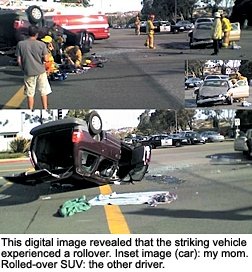Abstract
A single case study involving a 58-year-old female, short stature, overweight, who presented to a chiropractic office 24 hours after a frontal-collision accident in which she was the driver.
Objective
The objective was to present this unusual case's clinical rationale using an evidence-based approach to critical thinking and differential diagnosis. A critical method of thinking prior to actual physical examination is necessary and is commonly used in the emergency department, while awaiting the arrival of critically injured patients. This method is utilized in order to determine an algorithm of care. The doctor of chiropractic is asked to review the images provided of the scene of the accident while evaluating the various phases of forces that the occupant experienced.
Mechanism of Trauma and Phases in a Restrained Occupant
 Typically, in a frontal crash the vehicle will crash into another moving or stationary vehicle, lose control and strike some object. The striking vehicle's front end will be pushed inward, directing forces into the structural area of the struck vehicle's body frame, usually off-center. If pre-braking occurs in the frontal crash, the nose of the striking car will dive downward. If the restrained occupant is aware of the impending crash, attempts at bracing will occur. As the crush proceeds, forces will continue to be transmitted from the firewall into the seat frame, dash floorboard and steering wheel, as rapid deceleration forces occur within the occupant's cage. The front of the car typically will crush inward 2 feet, allowing the vehicle to move forward by about 2 feet before stopping suddenly. The vehicle stops before the occupant does and the occupant literally will run into the slowing car's interior as the seat belt tightens.
Typically, in a frontal crash the vehicle will crash into another moving or stationary vehicle, lose control and strike some object. The striking vehicle's front end will be pushed inward, directing forces into the structural area of the struck vehicle's body frame, usually off-center. If pre-braking occurs in the frontal crash, the nose of the striking car will dive downward. If the restrained occupant is aware of the impending crash, attempts at bracing will occur. As the crush proceeds, forces will continue to be transmitted from the firewall into the seat frame, dash floorboard and steering wheel, as rapid deceleration forces occur within the occupant's cage. The front of the car typically will crush inward 2 feet, allowing the vehicle to move forward by about 2 feet before stopping suddenly. The vehicle stops before the occupant does and the occupant literally will run into the slowing car's interior as the seat belt tightens.
Once the vehicle reaches maximum deceleration, the 2 feet of frontal crash ends with the driver's head, neck, torso, hips and knees moving forward faster than the seat beneath them. The restrained driver's left shoulder moves forward until the shoulder harness reaches its limits, holding back the left shoulder while the right shoulder moves forward. The right shoulder and torso may continue to move forward, causing head rotation and increasing the probability of a closed-head injury (concussion, etc.), intercostal sprains and other torso soft-tissue injury.
The driver's head, neck and torso reach peak deceleration levels, by which time the vehicle has stopped all forward motion. The shoulder belt harness may load up to 2,000 pounds of force, depending on collision speed. The pelvis moves forward and upward about 6 inches, depending on the lap-belt slack. While the torso is restrained, the entire neck is pulled forward, causing axial stretching.
The vehicle now goes through recoil. Most frontal impacts have about a 10 percent recoil velocity. The driver's head, neck and torso rebound backward into the seat. This causes deflection, which then springs the occupant forward again.
Just as important as the mechanism of trauma and its phases in collision injuries are the significant factors that play a role in a patient's prognosis, symptoms and disability, which have been documented in the literature. In this case, the other factors are the gender of the driver and their seating position. Most important, besides whether or not the driver is restrained, is if they sustain injuries. Seventy-two percent of drivers develop chronic symptoms. Go back and review this patient's chief complaints. Now, can you tie in the mechanism of injury or history of injury to the chief complaints, and formulate a care management plan?
Resources
- Lord MS, Barnsley L, Wallis BJ, Bogduk N. Chronic cervical zygapophysial joint pain after whiplash. A placebo-controlled prevalence study. Spine, Aug 1996;21(15):1737-44; discussion 1744-5.
- Deans GT, McGillard JN, Rutherford WH. Incidence and duration of neck pain among patients injured in car accidents. BMJ, 1986;292:94-5.
- Hohl M. Soft tissue injuries of the neck in automobile accidents. Factors influencing prognosis. J Bone Joint Surg, 1974;56(8):1675-82.
- Kahane CJ. An Evaluation of Head Restraints. Technical Report DOS-HS-806-108. Springfield, Va.: U.S. Department of Transportation, National Highway Traffic Safety Administration, 1982.
- Daffner RH, Deeb ZL, Lupetin AR, Rothfus WE. Patterns of high-speed impact injuries in motor vehicle occupants. J Trauma, 1988;28(4):498-501.
- Dean GT, Magelliard JN, Kerr M, Rutherford WH. Neck sprain - a major cause of disability following car accidents. Injury, 1987;18(1):10-2.
- Morris F. Do head-restraints protect the neck from whiplash injuries? Arch Emerg Med, 1989;6(1):17-21.
- Nygren A. Injuries to car occupants - some aspects of the interior safety of cars. A study of a five-year material from an insurance company. Acta Otolaryngal Suppl, 1984;395:1-164.
- Kischka U, Ettlin T, Helm S, Schmid G. Cerebral symptoms following whiplash injury. Eur Neurol, 1991;31(3):136-40.
- Hildingsson C, Toolanen G. Outcome after soft-tissue injury of the cervical spine. A prospective study of 93 car-accident victims. Acta Orthop Scand, 1990;61(4):357-9.
- Hohl M, Hoop E. Soft tissue injuries of the neck. II. Factors influencing prognosis. Orthop Transaction, 1978;2:29.
- Nordhoff LS. Motor Vehicle Collision Injuries. Gaithersburg, Md.: Aspen Publishers, 1996, pp 292-294.
- Maimaris C, Barnes HR, Allen MJ. Whiplash injuries of the neck: a retrospective study. Injury, 1988;19(6):393-6.
- Pennie BH, AgambarLJ. Whiplash injuries. A trial of early management. J Bone Joint Surg Br, 1990;72(2):277-9.
- Stano M. A comparison of health care costs for chiropractic and medical patients. JMPT, 1993;16(5):291-9.
- Stursenegger, M DiStefano G, Radanov BP, Schnidrig A. Presenting symptoms and signs after whiplash injury: the influence of accident mechanisms. Neurology, April 1994;44(4):688-93.
- Osterbauer PJ, Derickson KL, Peles JD, et al. Three-dimensional head kinematics and clinical outcome of patients with neck injury treated with spinal manipulative therapy: a pilot study. JMPT, Oct. 1992;15(8):501-11.
- Bannister GC, Gargan M. Prognosis of whiplash injuries: a review of the literature. In: Teasell RW, Shapiro AP, eds. Cervical Flexionextension/Whiplash Injuries. Spine: State of the Art Reviews, Vol 7. Philadelphia: Hanley and Belfus Inc, 1993, pp 557-6.
- Ebelin M, et al. Functional sequelae of benign cervical spine sprains from whiplash injuries: report on 61 cases. J Traumatol, 1981;2:77-81.
Click here for previous articles by Nancy Martin-Molina, DC, QME, MBA, CCSP.





